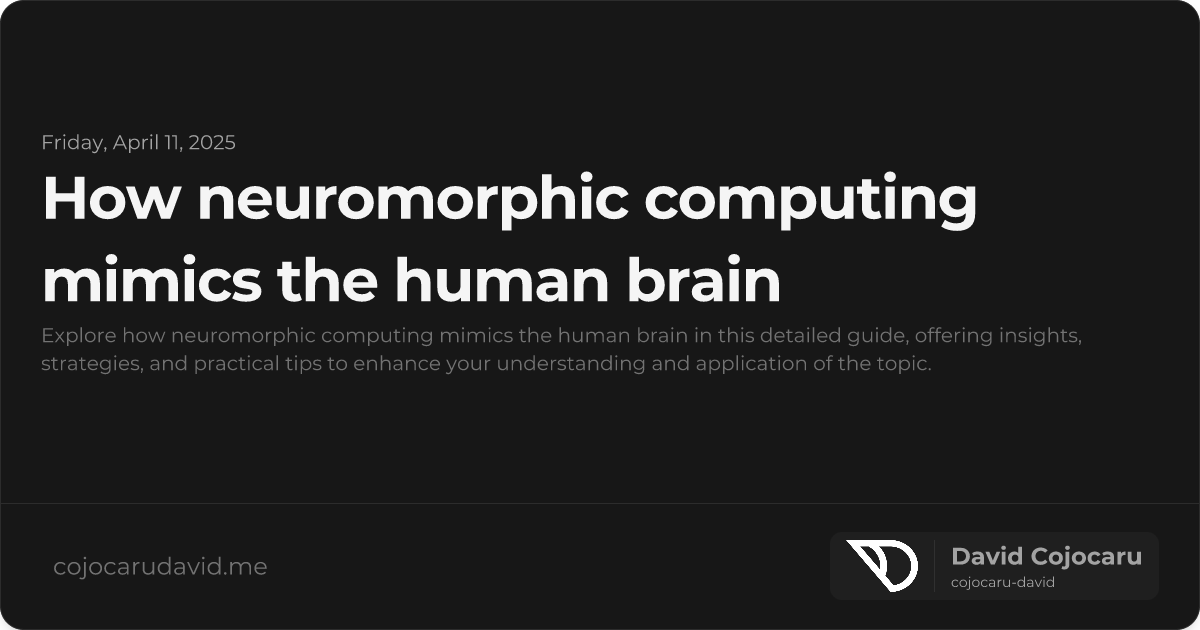Neuromorphic Computing: Unlocking AI’s Potential by Mimicking the Human Brain
Tired of AI that guzzles energy and struggles with real-time tasks? Neuromorphic computing offers a radical new approach, inspired by the very blueprint of intelligence: the human brain. This revolutionary field aims to create AI systems that are faster, more efficient, and far more adaptable.
In this post, we’ll delve into the fascinating world of neuromorphic computing, exploring how it works, its core components, and why it’s poised to reshape the future of artificial intelligence.
What Exactly Is Neuromorphic Computing?
Imagine a computer that learns and adapts like your brain. That’s the essence of neuromorphic computing. Unlike traditional computers that separate processing and memory (the von Neumann architecture), neuromorphic systems mimic the brain’s interconnected network of neurons and synapses, integrating these functions for optimal efficiency.
Think of it this way: instead of rigidly following instructions, a neuromorphic computer “thinks” more organically, learning from data and adapting to new situations.
Here are some key characteristics that define this cutting-edge technology:
- Parallel Processing: Handles multiple operations simultaneously, just like the brain multitasking effortlessly.
- Event-Driven Computation: Conserves energy by only activating neurons when necessary, significantly reducing power consumption.
- Adaptive Learning: Evolves and learns continuously from new data, eliminating the need for constant retraining.
These unique features enable neuromorphic systems to process sensory information, recognize complex patterns, and make intelligent decisions with remarkable speed and energy efficiency.
Decoding the Brain-Inspired Architecture
At the heart of neuromorphic computing lies a deep understanding of the brain’s intricate design.
Artificial Neurons and Synapses: Building Blocks of Intelligence
Neuromorphic chips are constructed using artificial neurons and synapses, mimicking the fundamental building blocks of the human brain. These components communicate through electrical spikes, mirroring the way biological neurons transmit signals.
For instance, IBM’s pioneering TrueNorth chip boasts:
- 1 Million Programmable Neurons: Allowing for complex and intricate networks.
- 256 Million Configurable Synapses: Enabling rich and dynamic connections.
- Ultra-Low Power Consumption: A game-changer for energy-efficient AI.
Spiking Neural Networks (SNNs): Emulating Brain Activity
Unlike traditional Artificial Neural Networks (ANNs), which process information continuously, Spiking Neural Networks (SNNs) leverage the timing of individual “spikes” to transmit information, closely replicating the brain’s communication methods. This innovative approach results in:
- Faster Decision-Making: Enabling real-time responses and quicker processing.
- Lower Energy Usage: Utilizing power only when a spike occurs, maximizing efficiency.
- Enhanced Real-Time Processing: Making them ideal for dynamic and rapidly changing environments.
Why Neuromorphic Computing Outshines Traditional Methods
Neuromorphic computing offers a wealth of advantages over conventional computing architectures:
- Unmatched Energy Efficiency: Consumes significantly less power than traditional AI models, making it sustainable and cost-effective.
- Real-Time, Continuous Learning: Adapts dynamically to new information without the need for extensive retraining, fostering continuous improvement.
- Robust Fault Tolerance: Maintains functionality even when some components fail, providing reliable performance in demanding conditions.
These capabilities make neuromorphic computing the perfect choice for edge computing, robotics, and a wide range of Internet of Things (IoT) applications.
Navigating the Challenges and Charting the Future
While the potential of neuromorphic computing is immense, it also faces significant challenges:
- Design Complexity: Creating hardware that truly replicates the brain’s intricacies is an exceptionally complex undertaking.
- Scalability Limitations: Current neuromorphic systems are limited in size and scope, hindering their ability to tackle large-scale problems.
- Software Compatibility Hurdles: Requires the development of entirely new programming paradigms tailored to brain-inspired architectures.
Fortunately, ongoing research is actively addressing these challenges, paving the way for more intelligent, autonomous, and energy-efficient systems in the future.
The Future is Brain-Inspired
Neuromorphic computing is more than just a technological advancement; it’s a bridge connecting the realms of artificial and biological intelligence. By emulating the brain’s structure and function, it opens up exciting new possibilities for AI that are both powerful and sustainable. With its unparalleled energy efficiency and real-time processing capabilities, neuromorphic computing is poised to revolutionize the world of artificial intelligence.
“The human brain is the most sophisticated computer ever created – neuromorphic computing brings us closer than ever before to unlocking its full potential.”

